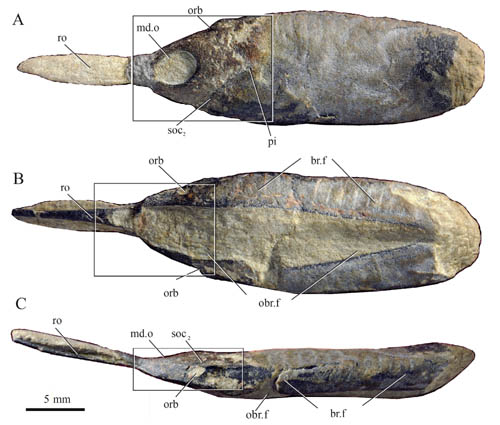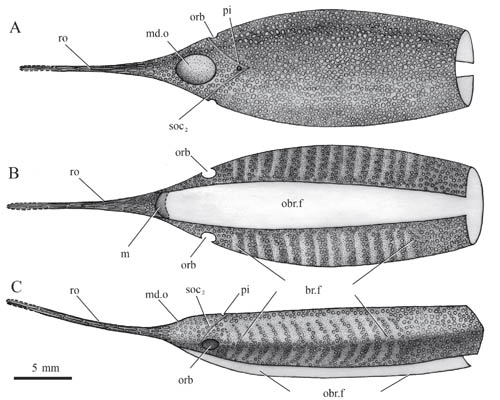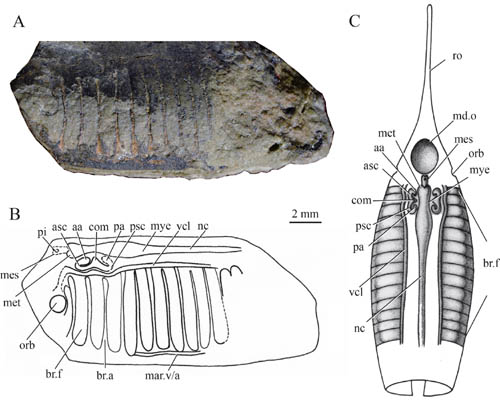New Streamlined Galeaspid (Jawless Fish)

Fig.1 Photograph of a complete head-shield of Rhegmaspis xiphoidea (IVPP V 19354.1A, holotype). A, dorsal view; B, ventral view; C, lateral view. (Image by GAI Zhi-Kun)

Fig.2 Restoration of Rhegmaspis xiphoidea. A, dorsal view; B, ventral view; C, lateral view. (Image by GAI Zhi-Kun)

Fig.3 Photograph (A), line drawing (B), and restoration (C) of the endocranium of Rhegmaspis xiphoidea. (IVPP V 19354.3) (Image by GAI Zhi-Kun)
The Galeaspida is a clade of armored jawless vertebrates. Most galeaspids have a strongly flattened head-shield, dorsally set eyes, and a ventral mouth, indicating a benthic lifestyle moving on sandy or muddy substrates in coastal, marine environment. Dr. ZHU Min, Institute of Vertebrate Paleontology and Paleoanthropology (IVPP), Chinese Academy of Sciences, and his team described a new galeaspid, Rhegmaspis xiphoidea, from the Lower Devonian Posongchong Formation of Zhaotong, Yunnan Province, China. The new form has a torpedo-shaped head-shield, a long rostral process and ventrolaterally set eyes, which highlight an adaptation to an active suprabenthic lifestyle as reported in the journal of Vertebrata PalAsiatica.
The new material was collected from a yellow sandstone layer of the Posongchong Formation (Pragian, Lower Devonian), near the dam of the Qingmen Reservoir in the suburb of Zhaotong, northeastern Yunnan, South China. The Posongchong Formation yields abundant vertebrate fossils including galeaspids, petalichthyids, arthrodires, antiarchs, and sarcopterygians. The vertebrate faunal members are assigned to the Sanchaspis-Asiaspis assemblage or the Xujiachong assemblage.
The new taxon is characterized by having a torpedo-shaped headshield, a long rostral process, ventrolaterally set orbits, and ventrally curved branchial fossae, but no corners, inner corners, and ventral rim of head-shield. It is assigned to the family Gantarostrataspidae that include Gantarostrataspis and Wumengshanaspis. According to the new material and new observation, the Gantarostrataspidae is emended and a fresh look is proposed for Gantarostrataspis and Wumengshanaspis.
The Galeaspida is known from the Telychian (Llandovery, Silurian) to the Late Devonian. Among jawless vertebrates, galeaspids are characterized by the festooned pattern of sensory canals on the dorsal side of head-shield, and a large median dorsal opening that serves as the main water intake device and the common nostril for separated nasal sacs and hypophysial duct.
The morphological adaption of Rhegmaspis indicates a strong selection for increased mobility and maneuverability during the Pragian of the Early Devonian. “As a streamlined jawless fish, Rhegmaspis displays an adaptation for a suprabenthic lifestyle with more active feeding behavior among galeaspids”, said Dr. GAI Zhi-Kun, lead author of the study, “The new form not only enriches the diversity of the Huananaspiformes, but also provides evidence for the last adaptive radiation of galeaspids by occupying an unexploited ecological niche during the Pragian of the Early Devonian.”
"This may explain why galeaspids, especially huananaspiforms, experienced a rapid radiation during the Pragian of the Early Devonian. After that, the diversity of galeaspids suddenly decreased, and few galeaspids survived into the Famennian of the Late Devonian", said ZHU Min.
The research was supported by Major Basic Research Projects of the Ministry of Science and Technology, China, the National Natural Science Foundation of China, and the State Key Laboratory of Palaeobiology and Stratigraphy (Nanjing Institute of Geology and Palaeontology, Chinese Academy of Sciences).
Download attachments: